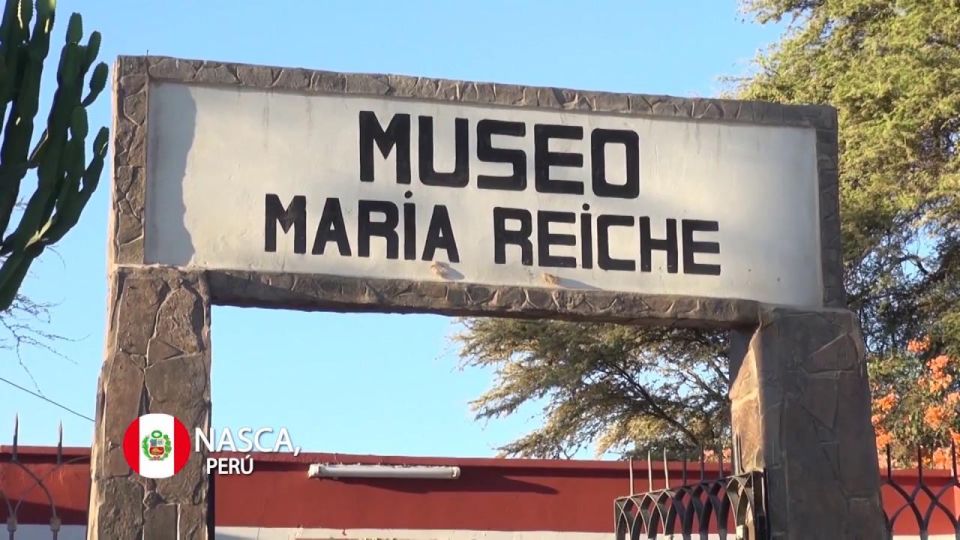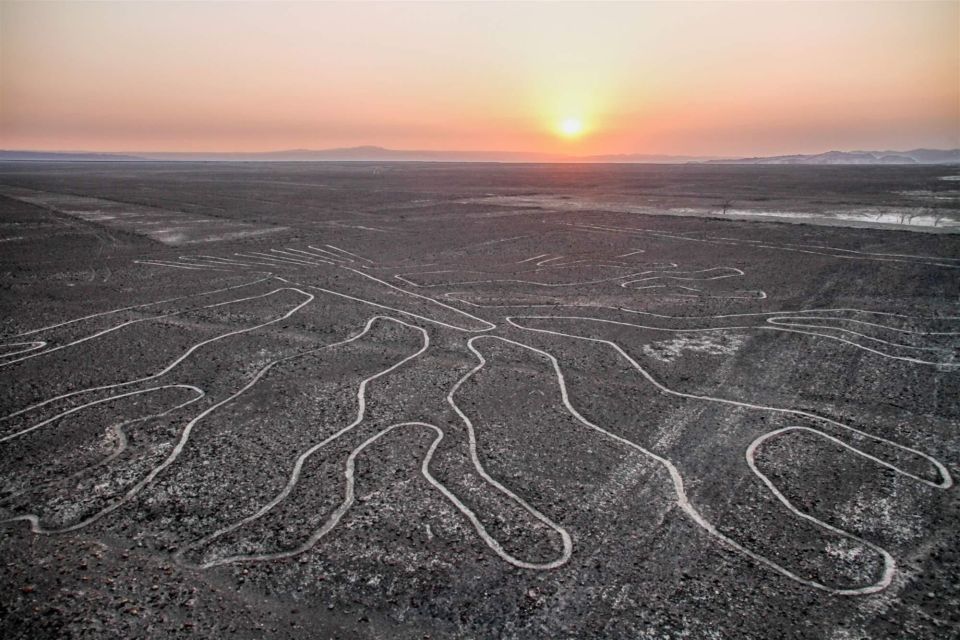Have you ever wondered how a single woman’s dedication could unravel the mysteries of the ancient Nazca Lines? Discover the Maria Reiche Museum and the Nazca Lines viewpoint in Peru, where Maria Reiche’s legacy comes to life.
As visitors step into this world, they are greeted with a blend of history and culture that promises an unforgettable journey. The museum offers a glimpse into the meticulous research of Reiche, while the viewpoint provides a unique perspective on the enigmatic Nazca geoglyphs.
Get ready to embark on a captivating exploration of the Nazca civilization and its intriguing geoglyphs.
Good To Know

- Maria Reiche’s research at the museum unravels the mysteries of the Nazca Lines.
- Explore Nazca culture and history through exhibits at the Maria Reiche Museum.
- Witness the Nazca Lines up close from the metallic viewpoint tower.
- Gain insights into the cultural significance and preservation of the UNESCO-listed Nazca Lines.
Maria Reiche: Nazca Lines Researcher

Maria Reiche dedicated her life to meticulously studying and safeguarding the enigmatic Nazca Lines in Peru. Her research techniques and preservation efforts have been instrumental in unraveling the geoglyph mysteries surrounding the Nazca Lines.
Through her work, Reiche made significant discoveries that shed light on the purpose and creation of these ancient figures, including animals, plants, and geometric shapes etched into the desert landscape. By meticulously documenting and analyzing the Nazca geoglyphs, Reiche played a pivotal role in advancing our understanding of this archaeological wonder.
Her unwavering dedication to preserving the Nazca Lines has left a lasting legacy, inspiring further exploration and appreciation of this UNESCO World Heritage Site.
Maria Reiche Museum Overview

Nestled in the heart of Nazca, the Maria Reiche Museum offers unique insights into the life and work of the renowned Nazca Lines researcher. Visitors can explore Maria Reiche’s legacy, exploring her dedication to studying and preserving the Nazca Lines. The museum showcases her significant discoveries, highlighting her contributions to Nazca archaeology.
Through exhibits, guests can gain a deeper understanding of the Nazca culture insights that Reiche unraveled during her research. The museum provides a comprehensive look at Reiche’s impact on the preservation of the geoglyphs and offers a glimpse into the mysteries surrounding the creation of the Nazca Lines. It stands as a tribute to her passion for unraveling the ancient secrets of the Nazca Desert.
Nazca Lines: Ancient Geoglyphs
The Nazca Lines, intricate ancient geoglyphs etched into the Nazca Desert in Peru, stand as enigmatic testaments to the creativity and ingenuity of the Nazca culture. These massive drawings serve various purposes, sparking debates about their intended functions among scholars. Some theories suggest they were astronomical calendars or markers for underground water sources.
The Nazca culture, flourishing between 500 BC and 500 AD, left behind these captivating geoglyphs that depict animals, plants, and geometric shapes. Their precise creation methods and the sheer scale of the designs continue to intrigue visitors, offering a glimpse into the rich history and mysterious practices of the Nazca people.
- Geoglyph purpose remains debated
- Theories include astronomical calendars
- Depictions of animals, plants, and shapes
- Created by the Nazca culture
- Testaments to Nazca culture’s creativity
Metallic Viewpoint Experience
From the elevated metallic viewpoint near the Nazca Lines, visitors can marvel at the intricate ancient geoglyphs etched into the desert landscape below. Viewing these mysterious markings from above provides an unparalleled aerial perspective, allowing guests to appreciate the immense scale and artistry of the Nazca Lines. These geoglyphs, created between 500 BC and 500 AD, continue to fascinate scholars and travelers alike, shrouded in historical mysteries regarding their purpose and origin. Engaging with these enigmatic figures from a heightened vantage point sparks contemplation and curiosity, inviting individuals to ponder the significance behind these ancient works of art.
| Metallic Viewpoint Experience | |
|---|---|
| Aerial Perspective | Historical Mysteries |
| Scale and Artistry | Scholarly Fascination |
| Contemplation Opportunities | Origin Speculations |
Tour Itinerary Highlights
Commencing the exploration of the tour itinerary highlights unveils a journey enriched with historical insights and immersive experiences. Visitors will:
Engage in viewpoint observation from a 20-meter tower to appreciate the intricate Nazca Lines.
Explore the Maria Reiche Museum to explore geoglyph mysteries and the life of the dedicated researcher.
Witness various Nazca geoglyphs from a nearby hill, expanding the understanding of their cultural significance.
Learn about the possible meanings and purposes behind the enigmatic Nazca Lines through guided discussions.
Immerse themselves in the history and heritage of the Nazca culture, gaining a deeper appreciation for Maria Reiche’s contributions to the preservation of these ancient wonders.
Inclusions in the Tour Package
Embarking on the exploration of the tour package, participants receive personalized attention and benefit from a guided experience that includes hotel pick-up service and transportation facilitated by a minibus. This personalized attention ensures that each participant feels attended to throughout the journey.
The convenience of hotel pick-up service in Nazca adds ease to the start of the tour, allowing travelers to focus on the upcoming experiences. The transportation provided by a minibus offers comfort and safety while moving between locations, enhancing the overall tour experience.
With these inclusions, participants can relax and enjoy the wonders of the Maria Reiche Museum and the Nazca Lines without worrying about logistical details.
Nazca Lines UNESCO Site
The Nazca Lines have been recognized as a UNESCO World Heritage Site due to their cultural and historical significance.
UNESCO debate: Scholars continue to debate the purpose behind the Nazca Lines, with theories ranging from astronomical calendars to religious rituals.
Preservation challenges: Ongoing preservation efforts face challenges such as environmental factors, tourism impact, and the need for sustainable management strategies.
Cultural significance: The Nazca Lines offer insights into the ancient Nazca culture’s artistic abilities and possibly their social and spiritual beliefs.
Historical importance: These geoglyphs provide a window into the past, showcasing the creativity and engineering skills of the Nazca people.
Global heritage: The UNESCO designation highlights the universal value of the Nazca Lines, emphasizing their importance for humanity as a whole.
Exploring Cultural Significance
Explorers can explore the cultural significance of the Nazca Lines by deciphering the intricate designs left behind by the ancient Nazca culture. These geoglyphs, created between 500 BC and 500 AD, showcase various figures like animals, plants, and geometric shapes.
Scholars engage in an ongoing interpretation debate regarding the purpose of these enigmatic lines. Efforts towards the preservation of the Nazca Lines have been crucial due to their historical and archaeological value.
The Maria Reiche Museum and the Nazca Lines viewpoint provide a platform for visitors to explore the cultural and historical significance of these geoglyphs, fostering discussions about their possible meanings and purposes. The legacy of Maria Reiche, a dedicated researcher focused on protecting the Nazca Lines, is also highlighted, enriching the understanding of this ancient marvel.
Common Questions
What Are the Best Times of Year to Visit the Nazca Lines in Terms of Weather and Visibility?
The best times to visit the Nazca Lines for ideal weather and visibility are during the dry season from May to October. Clear skies and minimal rainfall make this period optimal for observing the intricate geoglyphs.
Are There Any Specific Regulations or Restrictions in Place for Visitors at the Nazca Lines Viewpoint?
Visitor regulations and safety measures at the Nazca Lines viewpoint ensure preservation and visitor well-being. Rules include no touching or walking on the geoglyphs, strict no-drone policy, and designated paths for viewing. Guides enforce guidelines to protect this UNESCO World Heritage Site.
How Long Has the Maria Reiche Museum Been Open to the Public, and What Are Some of Its Most Popular Exhibits?
The Maria Reiche Museum has been open to the public for several years, offering visitors an immersive experience. Exhibits showcasing Nazca culture and Reiche’s research are popular, enhancing understanding of the area’s archaeological significance.
Are There Any Ongoing Conservation Efforts in Place to Protect the Nazca Lines From Environmental Damage or Degradation?
Conservation efforts are crucial in safeguarding the Nazca Lines from environmental damage. Measures like limiting foot traffic, monitoring erosion, and promoting sustainable tourism play a vital role in preserving these ancient geoglyphs for future generations to appreciate.
Are There Any Local Legends or Myths Surrounding the Creation of the Nazca Geoglyphs That Are Not Widely Known?
Local interpretations of the Nazca geoglyphs vary, reflecting cultural significance. Some believe the lines were created by gods, signaling celestial events. Others suggest they served as ritual paths. These diverse perspectives enrich the mystery of the Nazca Lines.
The Sum Up
To sum it up, the Maria Reiche Museum and Nazca Lines viewpoint offer a captivating journey into the ancient mysteries of the Nazca civilization. Visitors are treated to a unique experience, exploring the legacy of Maria Reiche and marveling at the intricate geoglyphs from a stunning vantage point.
With expert guidance and personalized attention, this tour provides a memorable and enlightening adventure through the fascinating world of the Nazca Lines.
You can check if your dates are available here: